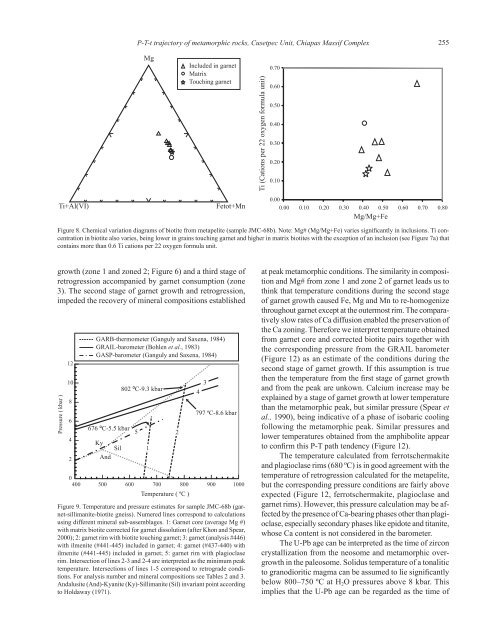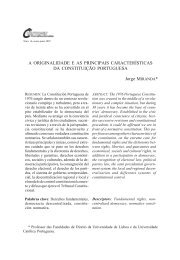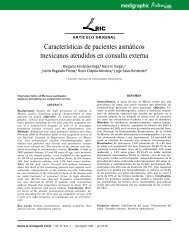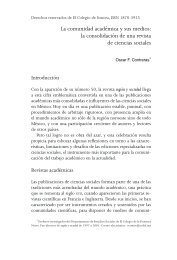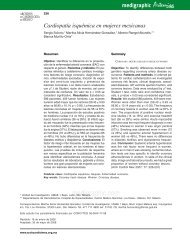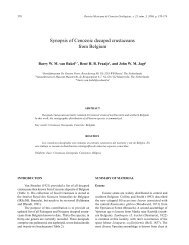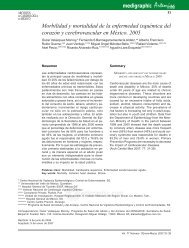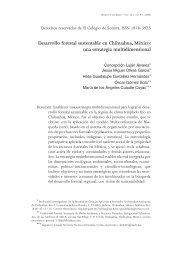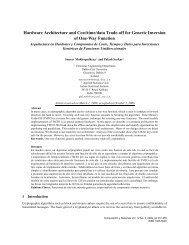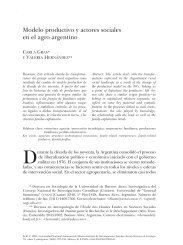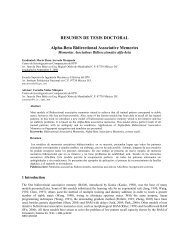P-T-t trajectory of metamorphic rocks from the central ... - SciELO
P-T-t trajectory of metamorphic rocks from the central ... - SciELO
P-T-t trajectory of metamorphic rocks from the central ... - SciELO
Create successful ePaper yourself
Turn your PDF publications into a flip-book with our unique Google optimized e-Paper software.
P-T-t <strong>trajectory</strong> <strong>of</strong> <strong>metamorphic</strong> <strong>rocks</strong>, Cusetpec Unit, Chiapas Massif Complex 255<br />
Figure 8. Chemical variation diagrams <strong>of</strong> biotite <strong>from</strong> metapelite (sample JMC-68b). Note: Mg# (Mg/Mg+Fe) varies significantly in inclusions. Ti concentration<br />
in biotite also varies, being lower in grains touching garnet and higher in matrix biotites with <strong>the</strong> exception <strong>of</strong> an inclusion (see Figure 7a) that<br />
contains more than 0.6 Ti cations per 22 oxygen formula unit.<br />
growth (zone 1 and zoned 2; Figure 6) and a third stage <strong>of</strong><br />
retrogression accompanied by garnet consumption (zone<br />
3). The second stage <strong>of</strong> garnet growth and retrogression,<br />
impeded <strong>the</strong> recovery <strong>of</strong> mineral compositions established<br />
Pressure ( kbar )<br />
12<br />
10<br />
8<br />
6<br />
4<br />
2<br />
GARB-<strong>the</strong>rmometer (Ganguly and Saxena, 1984)<br />
GRAIL-barometer (Bohlen et al. , 1983)<br />
GASP-barometer ( Ganguly and Saxena, 1984)<br />
676 ºC-5.5 kbar<br />
Ky<br />
Sil<br />
And<br />
802 ºC-9.3 kbar<br />
5<br />
1<br />
0<br />
400 500 600 700 800 900 1000<br />
2<br />
Temperature ( ºC )<br />
4<br />
3<br />
797 ºC-8.6 kbar<br />
Figure 9. Temperature and pressure estimates for sample JMC-68b (garnet-sillimanite-biotite<br />
gneiss). Numered lines correspond to calculations<br />
using different mineral sub-assemblages. 1: Garnet core (average Mg #)<br />
with matrix biotite corrected for garnet dissolution (after Khon and Spear,<br />
2000); 2: garnet rim with biotite touching garnet; 3: garnet (analysis #446)<br />
with ilmenite (#441-445) included in garnet; 4: garnet (#437-440) with<br />
ilmenite (#441-445) included in garnet; 5: garnet rim with plagioclase<br />
rim. Intersection <strong>of</strong> lines 2-3 and 2-4 are interpreted as <strong>the</strong> minimum peak<br />
temperature. Intersections <strong>of</strong> lines 1-5 correspond to retrograde conditions.<br />
For analysis number and mineral compositions see Tables 2 and 3.<br />
Andalusite (And)-Kyanite (Ky)-Sillimanite (Sil) invariant point according<br />
to Holdaway (1971).<br />
at peak <strong>metamorphic</strong> conditions. The similarity in composition<br />
and Mg# <strong>from</strong> zone 1 and zone 2 <strong>of</strong> garnet leads us to<br />
think that temperature conditions during <strong>the</strong> second stage<br />
<strong>of</strong> garnet growth caused Fe, Mg and Mn to re-homogenize<br />
throughout garnet except at <strong>the</strong> outermost rim. The comparatively<br />
slow rates <strong>of</strong> Ca diffusion enabled <strong>the</strong> preservation <strong>of</strong><br />
<strong>the</strong> Ca zoning. Therefore we interpret temperature obtained<br />
<strong>from</strong> garnet core and corrected biotite pairs toge<strong>the</strong>r with<br />
<strong>the</strong> corresponding pressure <strong>from</strong> <strong>the</strong> GRAIL barometer<br />
(Figure 12) as an estimate <strong>of</strong> <strong>the</strong> conditions during <strong>the</strong><br />
second stage <strong>of</strong> garnet growth. If this assumption is true<br />
<strong>the</strong>n <strong>the</strong> temperature <strong>from</strong> <strong>the</strong> first stage <strong>of</strong> garnet growth<br />
and <strong>from</strong> <strong>the</strong> peak are unkown. Calcium increase may be<br />
explained by a stage <strong>of</strong> garnet growth at lower temperature<br />
than <strong>the</strong> <strong>metamorphic</strong> peak, but similar pressure (Spear et<br />
al., 1990), being indicative <strong>of</strong> a phase <strong>of</strong> isobaric cooling<br />
following <strong>the</strong> <strong>metamorphic</strong> peak. Similar pressures and<br />
lower temperatures obtained <strong>from</strong> <strong>the</strong> amphibolite appear<br />
to confirm this P-T path tendency (Figure 12).<br />
The temperature calculated <strong>from</strong> ferrotschermakite<br />
and plagioclase rims (680 ºC) is in good agreement with <strong>the</strong><br />
temperature <strong>of</strong> retrogression calculated for <strong>the</strong> metapelite,<br />
but <strong>the</strong> corresponding pressure conditions are fairly above<br />
expected (Figure 12, ferrotschermakite, plagioclase and<br />
garnet rims). However, this pressure calculation may be affected<br />
by <strong>the</strong> presence <strong>of</strong> Ca-bearing phases o<strong>the</strong>r than plagioclase,<br />
especially secondary phases like epidote and titanite,<br />
whose Ca content is not considered in <strong>the</strong> barometer.<br />
The U-Pb age can be interpreted as <strong>the</strong> time <strong>of</strong> zircon<br />
crystallization <strong>from</strong> <strong>the</strong> neosome and <strong>metamorphic</strong> overgrowth<br />
in <strong>the</strong> paleosome. Solidus temperature <strong>of</strong> a tonalitic<br />
to granodioritic magma can be assumed to lie significantly<br />
below 800–750 ºC at H 2 O pressures above 8 kbar. This<br />
implies that <strong>the</strong> U-Pb age can be regarded as <strong>the</strong> time <strong>of</strong>


